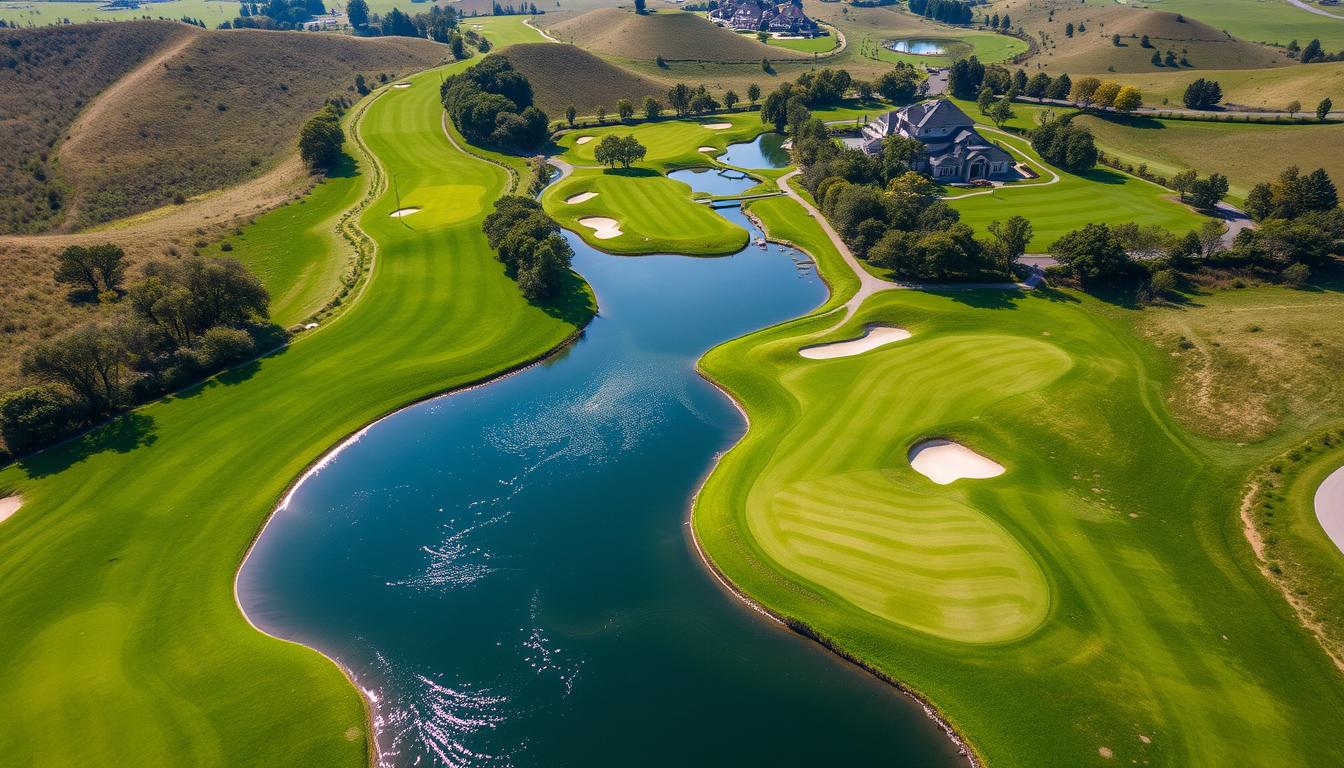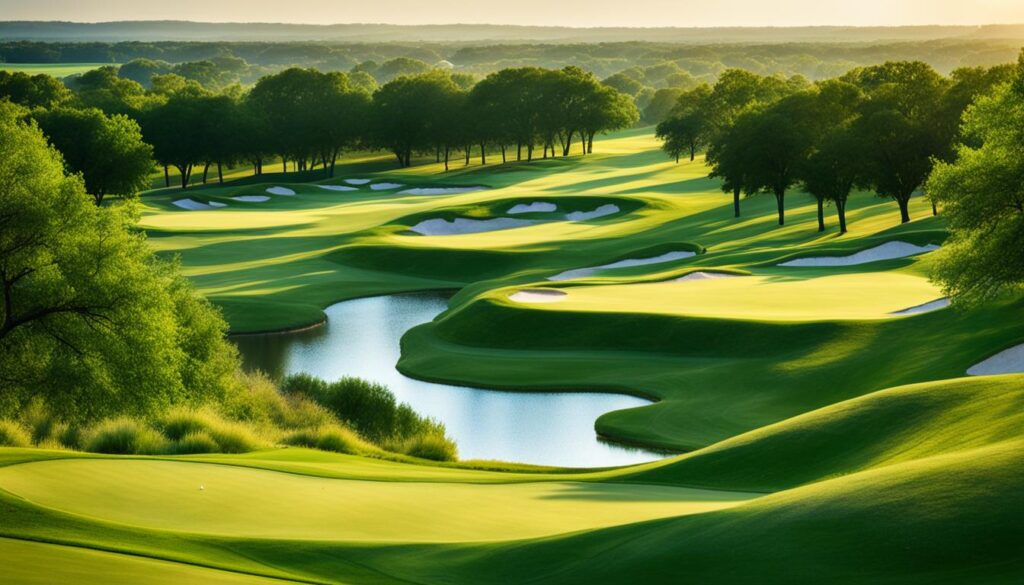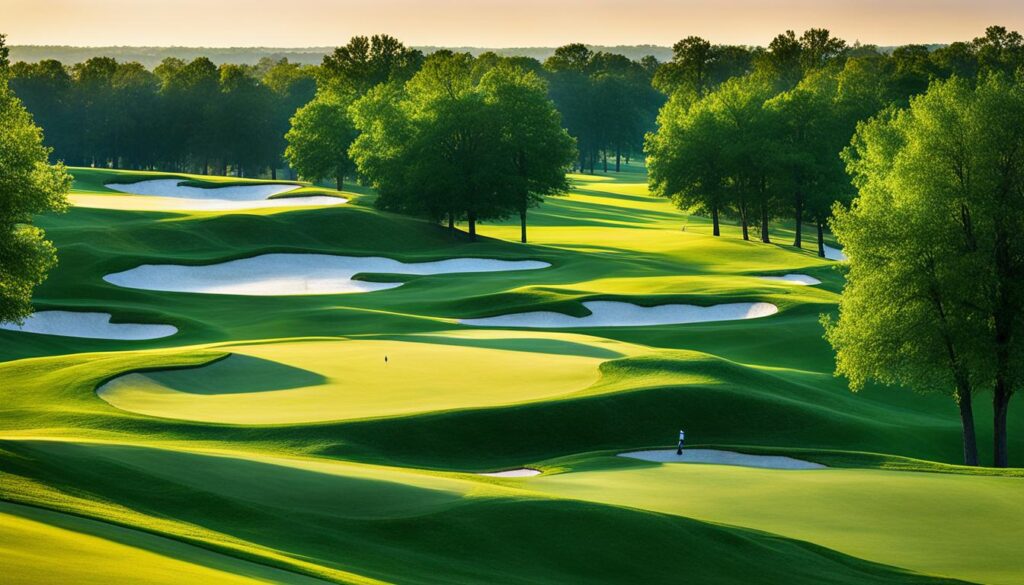Did you know a golf course can cost anywhere from $2 million to $269 million? This huge range shows how different golf course values are in the real estate world. The Trump Golf Links is a top example of this high price.
But golf course prices aren’t just about nice greens and fairways. Many things affect a course’s value. Location, what amenities it has, and how profitable it is all matter.
In recent years, the golf world has grown a lot. It increased by 20% from 2016, reaching $101.7 million. This growth comes from more people playing, including young folks, women, and people of color.
For those looking to invest, golf courses can be good choices. In 2022, the average price was $3.1 million. Most buyers were new to owning a golf course. This shows more people are interested in golf course investments.
Key Takeaways
- Golf course prices range from $2 million to $269 million
- Location, amenities, and profitability are important factors in pricing
- The golf market grew 20% from 2016 to $101.7 million
- Average purchase price in 2022 was $3.1 million
- Most buyers are first-time golf course owners
- Golf courses can be profitable real estate investments
Table of Contents
- 1 Factors Influencing Golf Course Value
- 2 Financial Performance and Revenue Streams
- 3 Average Price Range for Golf Courses
- 4 Notable Golf Course Sales and Their Prices
- 5 The Role of PGA Tournaments in Course Value
- 6 Impact of Luxury Accommodations on Golf Course Worth
- 7 Public vs. Private Courses: Value Differences
- 8 Golf Course Investment: Potential Returns
- 9 The Process of Buying a Golf Course
- 10 Evaluating a Golf Course’s Financial Performance
- 11 The Importance of Location in Golf Course Valuation
- 12 Golf Course Appraisal Methods
- 13 Challenges in Determining Golf Course Worth
- 14 The Role of Potential Development in Course Value
- 15 Impact of Golf Industry Trends on Course Prices
- 16 Financing Options for Golf Course Purchases
Factors Influencing Golf Course Value

Golf course value depends on several critical elements. Knowing these factors helps buyers and investors make smart choices in the golf real estate market.
Location and Real Estate
Location is important in determining a golf course’s value. Coastal states like California, Florida, and Hawaii often have higher real estate values. A study in College Station, Texas, found that homes near golf courses sold for $61,074 more, which is 25.8% of the average home price.
Course Design and Condition
The quality of course design affects how enjoyable it is to play. Well-designed courses attract more players, which can increase revenue. Keeping the course in top condition is crucial, as poor upkeep can lower its value. Building an 18-hole golf course can cost between $3 million and $10 million, not including land costs.
Amenities and Facilities
Golf amenities and facilities greatly impact a course’s value. Features like spas, restaurants, and luxury accommodations can boost appeal and revenue. Over 75% of new golf courses are part of larger real estate projects, showing the importance of integrated facilities.
| Factor | Impact on Value |
|---|---|
| Prime Location | Increase up to 25.8% |
| Quality Course Design | $3-10 million investment |
| Integrated Amenities | Enhanced appeal and revenue |
By focusing on these factors, golf course owners can increase their property’s value. This makes it more appealing to potential buyers or investors in the competitive golf real estate market.
Financial Performance and Revenue Streams
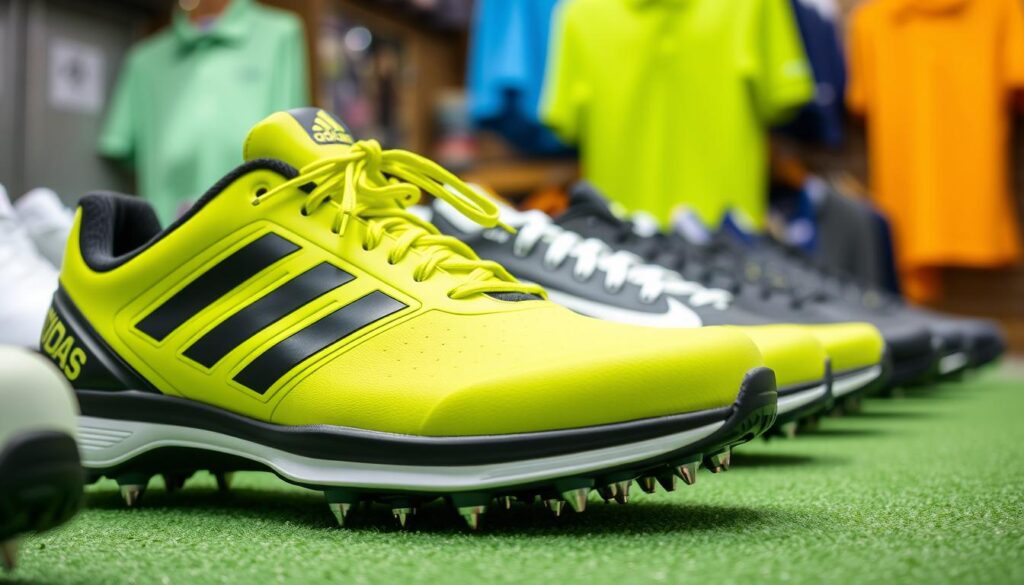
Golf course value depends on its financial health. Different revenue streams add to a course’s worth. We will look at the main sources of golf revenue and their impact on a course’s finances.
Membership and Green Fees
Membership fees are a steady income for many golf courses. They ensure a constant flow of money, supporting operations all year. Green fees from non-members also increase revenue. These fees change based on the course’s fame and busy times.
| Time | Weekday Green Fee | Weekend Green Fee |
|---|---|---|
| Morning | $75 | $95 |
| Afternoon | $60 | $80 |
| Twilight | $45 | $65 |
Ancillary Income Sources
Golf courses also earn from various other sources. Sales from the pro shop, golf cart rentals, and food and drinks are big contributors. In fact, food and drink sales jumped 42% from 2015 to 2016. Hosting events like weddings and charity tournaments can also increase revenue and fame.
Online shopping on golf course websites opens new sales channels. Loyalty programs can also boost spending, with 57% of customers spending more on brands they love. By exploring different income sources, golf courses can stay financially stable and grow in value.
Average Price Range for Golf Courses

Golf course prices vary a lot, showing the wide range of these properties. They can cost from low seven figures to over $200 million. In 2022, the average price was $3.1 million, according to Leisure Investment Properties Group.
Several factors affect golf course prices. Location is critical, with places like California, Florida, and Hawaii being more expensive. The state of facilities, equipment, and membership sales also play a role in golf course prices.
The market has changed over the years. Properties bought in 2006 have lost about 50% of their value. For instance, a course bought for $5 million might now be worth $2.5 million. This makes golf courses more affordable for new buyers.
| Golf Course | Location | Price |
|---|---|---|
| Belleview Biltmore Golf Club | Florida | $3.8 million |
| PGA National Resort & Spa | Palm Beach Gardens, Florida | $80+ million |
| Average Golf Course | United States | $3.1 million |
While some courses, like PGA National Resort & Spa in Florida, cost over $80 million, many are more affordable. The current market offers good chances for investors, with prices generally lower than before the Great Recession.
Notable Golf Course Sales and Their Prices

Golf course sales have been buzzing lately. Many high-profile deals have caught our attention. They show the varied values in the golf world.
PGA National Resort and Spa
In 2018, the PGA National Resort and Spa was sold for $218 million. The new owners then spent $100 million on renovations in 2022. This big investment shows it’s a top golf spot.
Gold Canyon Golf Resort
The Gold Canyon Golf Resort in Arizona was sold for about $30 million in 2020. This sale proves that good golf spots in great places are still valuable.
Links at Brick Landing
The Links at Brick Landing in North Carolina was bought for $1.2 million in 2020. This deal shows how prices vary. It depends on location, condition, and demand.
| Golf Course | Weekday Rate | Weekend Rate | Twilight Rate |
|---|---|---|---|
| PGA National Resort and Spa | $237 | $307 | $167 |
| Gold Canyon Golf Resort | $129 | $159 | $89 |
| Links at Brick Landing | $59 | $69 | $49 |
These sales show how different golf course values can be. Location, amenities, and prestige are vital in the golf resort market.
The Role of PGA Tournaments in Course Value

PGA events are vital to increasing a golf course’s value. Hosting tournaments boosts the course’s prestige. This attracts more golfers and justifies higher green fees. The effect on a course’s worth is huge.
Hosting major PGA tournaments can be very profitable. U.S. Open hosts often get facility fees over $2 million. Clubs can also make money from merchandise sales, earning between $3.9 million and $9.3 million.
Hosting PGA events does more than just make money. It also improves a course’s reputation in the golf world. This can lead to more members joining the club.
| Event Type | Green Fees | Tee Times |
|---|---|---|
| PGA Championship | $500 – $600 | 7:00 AM – 2:00 PM |
| U.S. Open | $550 – $650 | 6:30 AM – 3:00 PM |
| The Masters | $400 – $500 | 8:00 AM – 2:30 PM |
Hosting major events needs a lot of work and might disrupt regular play. But, many clubs see it as part of their mission. The long-term benefits of increased value and prestige are worth the short-term challenges.
Impact of Luxury Accommodations on Golf Course Worth
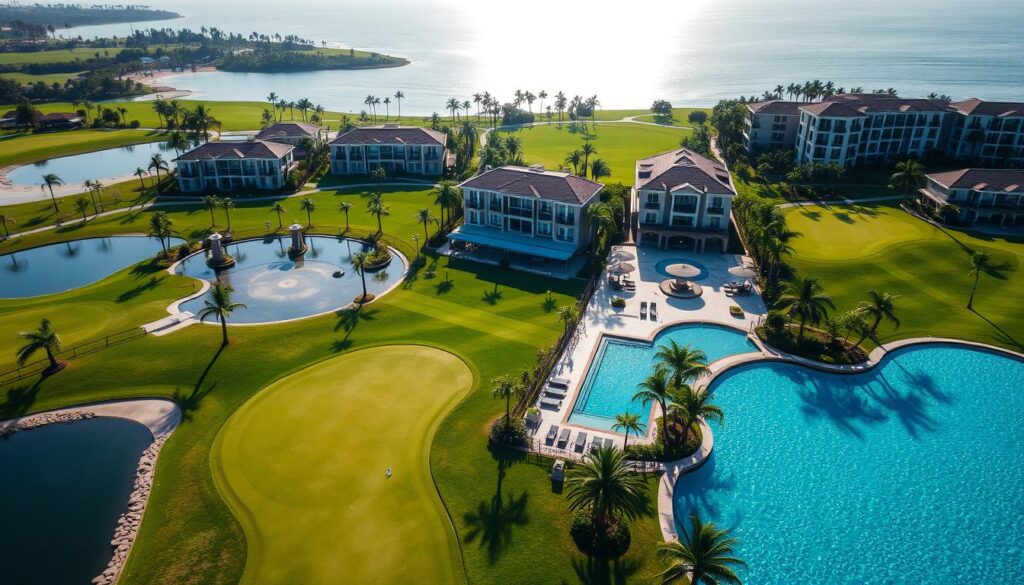
Luxury golf resorts with top-notch amenities greatly increase their value. These places offer more than golf; they give guests a full experience. They attract more visitors, boosting revenue and property value.
Golf courses with luxury spots charge more for green fees and memberships. They have world-class spas, fine dining, and fitness centers. These extras make golf better and attract non-golfers, expanding the resort’s appeal.
| Resort | Accommodations | Amenities | Green Fees (Peak Season) |
|---|---|---|---|
| PGA National Resort | 339 rooms | 40,000 sq ft spa, 5 golf courses | $399 |
| Pebble Beach Resorts | 495 rooms | Beach club, 4 golf courses | $575 |
| Pinehurst Resort | 480 rooms | Spa, 9 golf courses | $495 |
Properties with golf course views can be 15-30% more valuable. This shows how much people want luxury golf resorts. The mix of great golf and luxury amenities makes these places very valuable.
Public vs. Private Courses: Value Differences

Public golf courses and private clubs differ a lot in value, amenities, and experience. Private clubs are more expensive because they have exclusive memberships and steady income.
Public courses are open to everyone and make money from daily fees. These fees can change, affecting their value. On the other hand, private clubs get stable income from membership fees and dues. This makes them appealing to investors.
Now, let’s look at some typical fees and rates for both types of courses:
| Course Type | Green Fees | Membership Fees | Tee Time Availability |
|---|---|---|---|
| Public | $30 – $100 per round | N/A | First-come, first-served |
| Private | Included in membership | $212 – $1000+ per month | Exclusive member booking |
Private clubs spend a lot on course upkeep and amenities like pro shops and restaurants. These investments lead to higher prices, with private clubs averaging nearly $3,000,000. Public courses average around $2,400,000.
Public courses offer easy access and variety, while private clubs provide exclusivity and community. Your choice depends on your golfing style and budget.
Golf Course Investment: Potential Returns
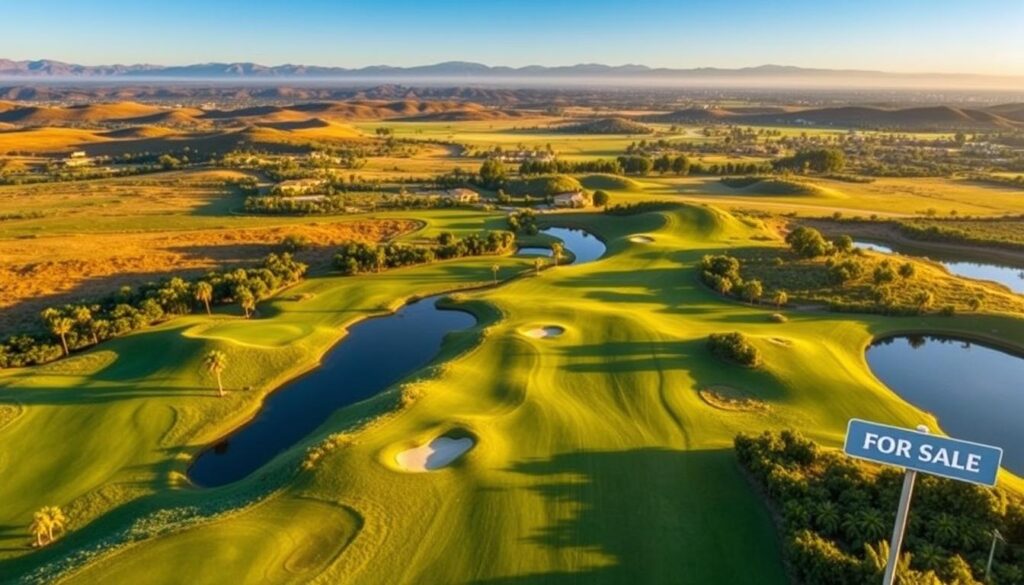
Investing in a golf course can be very profitable. But, it’s important to know the potential gains and risks. The success of a golf course depends on many factors.
The golf industry has grown a lot, reaching $101.7 million recently. This growth shows good chances for investors. However, about 25% of golf courses don’t make money, so think carefully before investing.
Profitable golf courses often sell for six to eight times their earnings before interest, taxes, depreciation, and amortization (EBITDA). Less successful ones might sell for 0.8 to 1.4 times their revenue. To get the most from your investment, focus on these areas:
- Location and market demand
- Efficient management practices
- Diverse revenue streams (greens fees, memberships, food and beverage)
- Property value appreciation (15-30% for golf course views)
Remember, weather can affect course operations and profits. Good financial management is critical. Labor costs should be about 40% of sales, and overhead around 32%.
| Revenue Source | Target Percentage |
|---|---|
| Food Costs | 36% of sales |
| Beer and Wine | 32% of sales |
| Liquor | 26% of sales |
| Pro Shop Merchandise | 60-65% of sales |
Golf course investments can bring big returns. But, they need careful planning and management for lasting success and a good ROI.
The Process of Buying a Golf Course
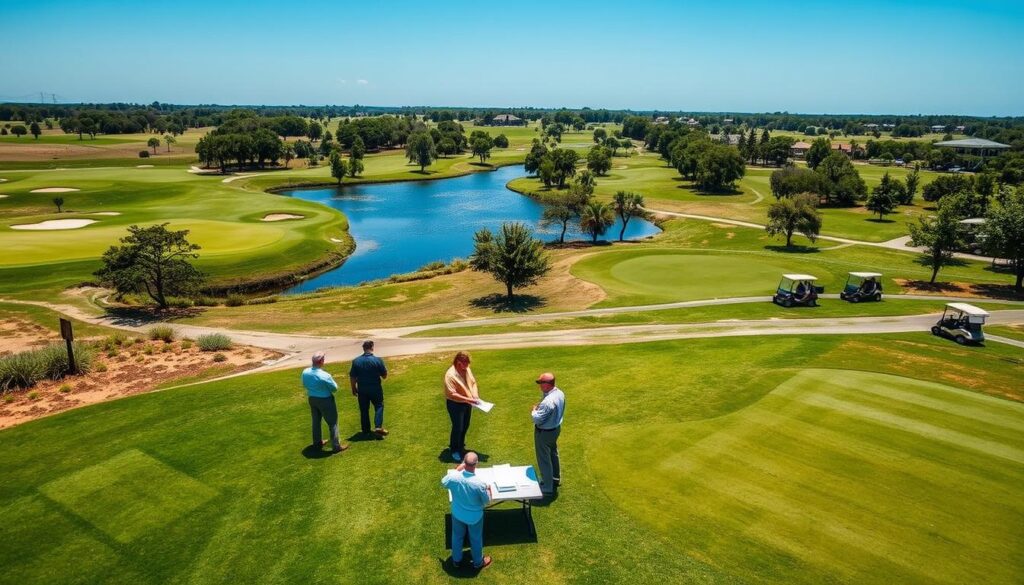
Buying a golf course is a detailed process. It involves thorough research and due diligence. Understanding the golf industry is critical, given its unique challenges. With 25.6 million golfers in the U.S. as of 2022, there’s a big market for smart investors.
Initial Research and Considerations
Begin by setting your goals for buying a golf course. Think about the location, type of course, and your financial aims. Look into local demographics and how many people play golf there. Good courses focus on great customer service, especially when they charge more.
Due Diligence Steps
Due diligence is essential in buying a golf course. Check the course’s financial health, including income from green fees, pro shop sales, and food and drinks. Also, look at maintenance costs, which can be very high. A new irrigation system can cost between $1 million to $3 million.
| Aspect | Considerations |
|---|---|
| Financial Performance | Revenue streams, profitability, operating costs |
| Course Condition | Maintenance needs, irrigation system status |
| Market Position | Competitor analysis, local golf demand |
Working with Golf Course Brokers
Golf course brokers can be very helpful. They know the market well and can find properties not listed publicly. They also understand how to value golf courses, which often sell for less than their worth.
Evaluating a Golf Course’s Financial Performance
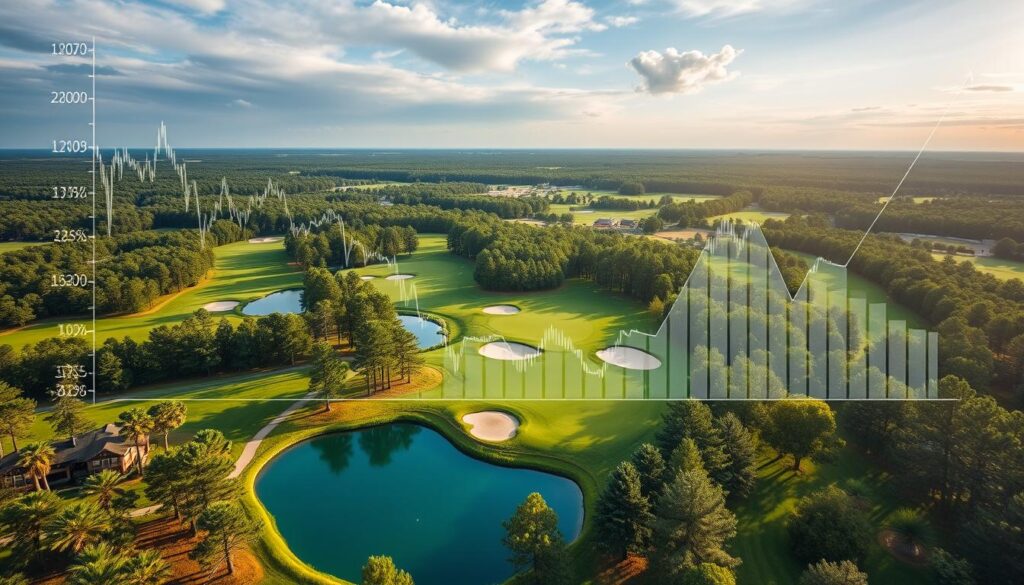
Understanding a golf course’s financials is important to knowing its value. Revenue analysis and expense management are crucial. Golf courses make money from membership fees, green fees, and other services.
A golf course’s health depends on balancing its income and expenses. Keeping costs down for maintenance, staff, and upkeep is important. Smart budgeting can greatly improve a course’s finances.
Financial reports are vital for checking a golf course’s performance. Breaking down costs from operations, capital, and maintenance helps understand its finances. Some courses save money for future upgrades and replacements.
| Revenue Stream | Percentage of Total Revenue |
|---|---|
| Membership Fees | 40% |
| Green Fees | 30% |
| Pro Shop Sales | 15% |
| Food and Beverage | 10% |
| Events and Tournaments | 5% |
Golf course owners must balance keeping dues low and avoiding extra fees. This requires careful planning and clear communication with members. Regular financial checks and standard reporting help keep a course financially healthy and valuable.
The Importance of Location in Golf Course Valuation

Golf course location is crucial for its value and demand. The right location can greatly increase a course’s worth. This affects both its current earnings and future growth.
Places near the coast or with year-round play tend to be more valuable. Being close to cities or tourist spots also matters. Easy access, like being near highways or airports, attracts more players and investors.
The golf industry has shown strong resilience. After a downturn, post-COVID demand has surged. The National Golf Foundation found 26.6 million people played golf in the U.S. in 2023. This includes 6 million new or returning players.
Location is not just about the course. Properties with golf views can be 15% to 30% more valuable. Even if they’re not part of the course. This golf course location premium highlights the need for a strategic choice.
| Factor | Impact on Value |
|---|---|
| Year-round play | Higher |
| Coastal location | Higher |
| Urban proximity | Higher |
| Tourist attraction nearby | Higher |
| Good accessibility | Higher |
Investors should look at climate and player patterns. Tools like Realtor.com’s maps and U.S. Bureau of Economic Analysis data help. They offer insights into property values and economic trends.
Golf Course Appraisal Methods
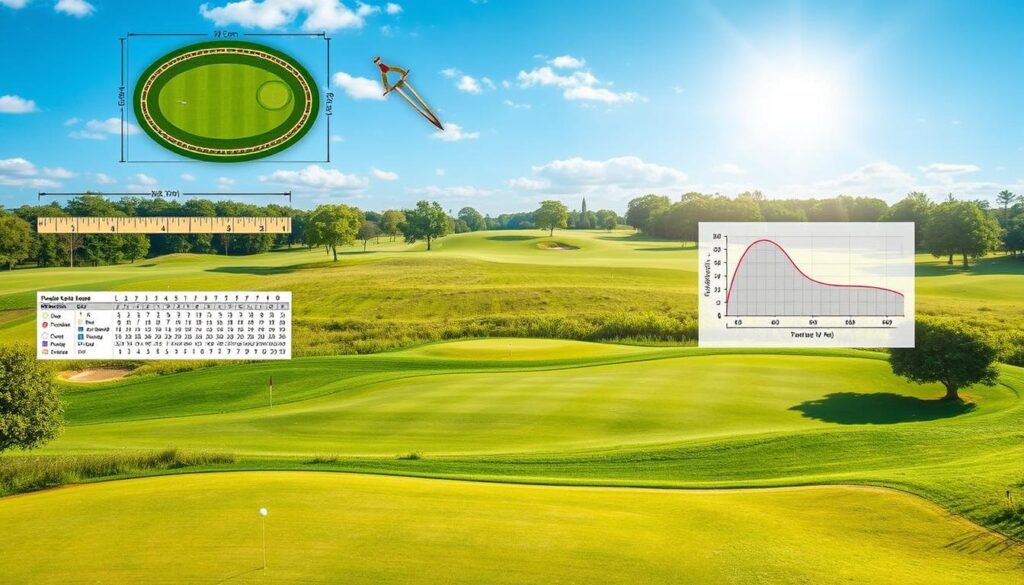
Golf course appraisal is a complex task that needs special skills and methods. Experts use different ways to figure out how much these properties are worth. Knowing these methods helps understand how golf course values are determined.
Income Approach
The income approach is important for golf courses that are open to the public. It looks at how much money the course makes. Appraisers check the cash flow by looking at income and expenses.
They consider things like green fees, membership fees, and sales from the course’s restaurant and shop.
Comparable Sales Approach
This method compares the golf course to others that have sold recently. It makes adjustments for things like quality and amenities. For example, Pine Valley Golf Course in Southington, Connecticut, sold for $7.9 million in 2014.
This sale can help figure out the value of other golf courses. You can learn more about golf course valuation here.
Cost Approach
The cost approach looks at what it would cost to build the course again. It’s not used much because it’s hard to figure out the depreciation of older courses. This method also has issues with construction costs and what buyers are willing to pay.
| Appraisal Method | Key Considerations | Challenges |
|---|---|---|
| Income Approach | Revenue streams, operating expenses | Projecting future income |
| Comparable Sales | Recent sales, market trends | Finding truly comparable properties |
| Cost Approach | Replacement value, depreciation | Accurately estimating depreciation |
Appraisers look at many things like location and amenities when valuing golf courses. The COVID-19 pandemic has also affected golf course appraisals. Usually, a mix of these methods gives the best idea of a golf course’s value.
Challenges in Determining Golf Course Worth

Figuring out the value of a golf course is tricky. Market changes make it hard to find a precise value. Each course is unique, adding to the complexity.
Golf courses are more than just land. They are businesses with different ways to make money. This makes it hard to use old methods to value them. You have to look at things like membership numbers and green fees.
Different types of golf courses need different ways to value them. Private clubs, public courses, and resort courses all have their own rules. In some places, rules make all courses seem like public ones, which isn’t always true.
| Course Type | Valuation Approach | Key Considerations |
|---|---|---|
| Private Clubs | Income Approach | Membership dues, operating costs |
| Public Daily Fee | Sales Comparison | Green fees, rounds played |
| Resort Courses | Income + Cost Approach | Amenities, seasonal fluctuations |
The sales comparison method isn’t always reliable today. Many sales are not stable. Experts say using several methods is best to understand a course’s value.
The Role of Potential Development in Course Value
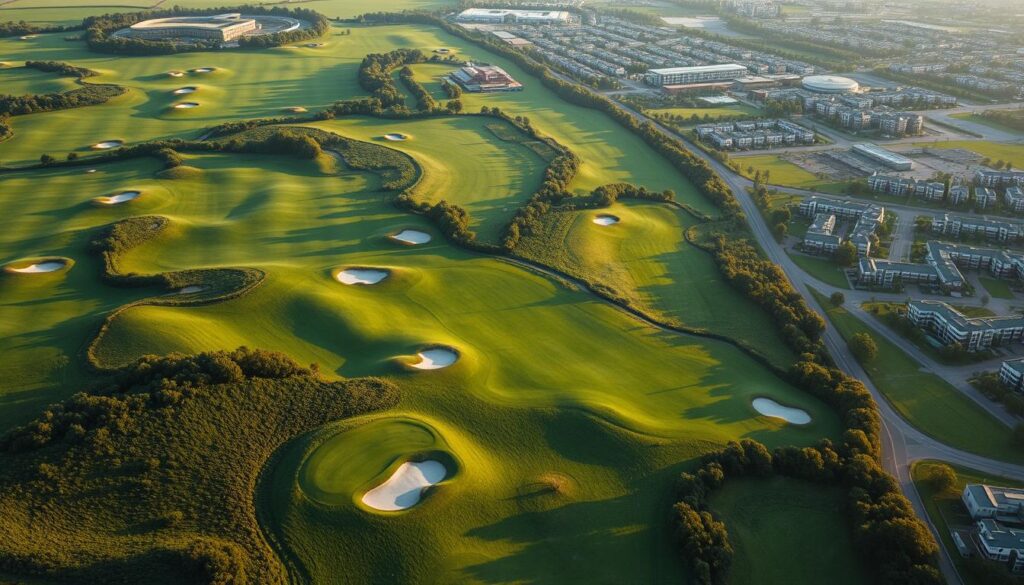
Golf courses have a lot of potential for development, which affects their value. These large areas attract investors who see more than just golf. The chance to turn these spaces into homes or businesses can increase their worth, especially in good locations.
Thinking about land development can change a golf course’s price a lot. Investors might buy courses to build houses or businesses. This can make a lot of money, especially where people want to live or work.
But turning a golf course into real estate isn’t easy. Laws, environmental rules, and local opposition can stop plans. This makes it hard to balance keeping the golf course and making money from the land.
| Factor | Impact on Golf Course Value |
|---|---|
| Prime Location | Increases development potential and value |
| Zoning Restrictions | May limit development options and decrease value |
| Environmental Concerns | Can restrict development and affect pricing |
| Community Opposition | Might hinder development plans and impact value |
It’s important to understand these factors for golf course investments. The mix of golf and land development can really affect a property’s value. Doing your homework is important before buying.
Impact of Golf Industry Trends on Course Prices
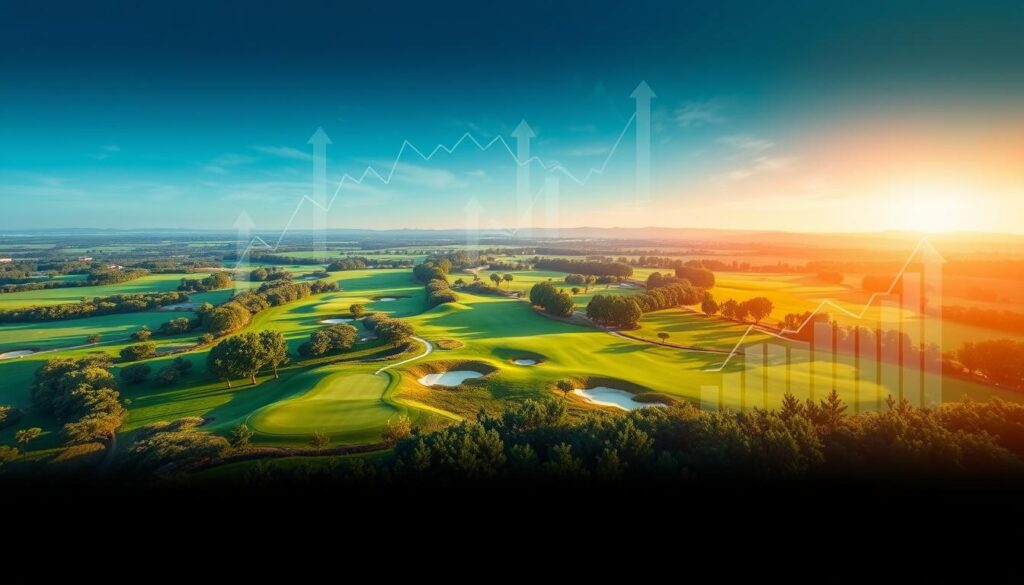
Golf industry trends are critical in setting course prices. Recent studies show big changes in who plays golf. More young people, women, and diverse groups are joining, making golf more popular.
In 2023, golf rounds went up 3% from 2022. This shows more people are interested. Simulator golf, in particular, has seen a huge jump of 73% since 2019. Now, over 6.2 million Americans play this tech-based version of golf.
The way people play golf is changing. Since 2019, more juniors, people of color, and women are playing. This change is making courses rethink their prices and what they offer.
| Category | Participation Increase Since 2019 |
|---|---|
| Juniors | 36% |
| People of Color | 17% |
| Women | 15% |
Green fees have gone up by 15% since 2021. This rise in prices affects how much courses are worth. Golf spots are also making more money from food and drinks. Sales of these items have almost tripled compared to sales from pro shops.
Financing Options for Golf Course Purchases
Buying a golf course is a big investment. Luckily, there are many golf course loans and financing options to help you. The Small Business Administration (SBA) offers the SBA 7(a) and 504 loans for equipment or working capital. These loans need good credit scores and proof of profit.
For fast funding, consider commercial bridge loans. They cover up to 80% of the property value and close quickly. Hard money or private money loans offer LTVs between 50% to 65%. Some lenders even have no- or low-documentation loans for golf courses.
Looking for big financing? Some lenders offer loans up to $10 million for golf course purchases. Bank financing can go up to 85% LTV for buying, refinancing, or starting a golf course. The U.S. Department of Agriculture’s Business and Industry loans are also an option. With these choices, you can put down as little as 30% and get a 25-year loan term for your golf course.
